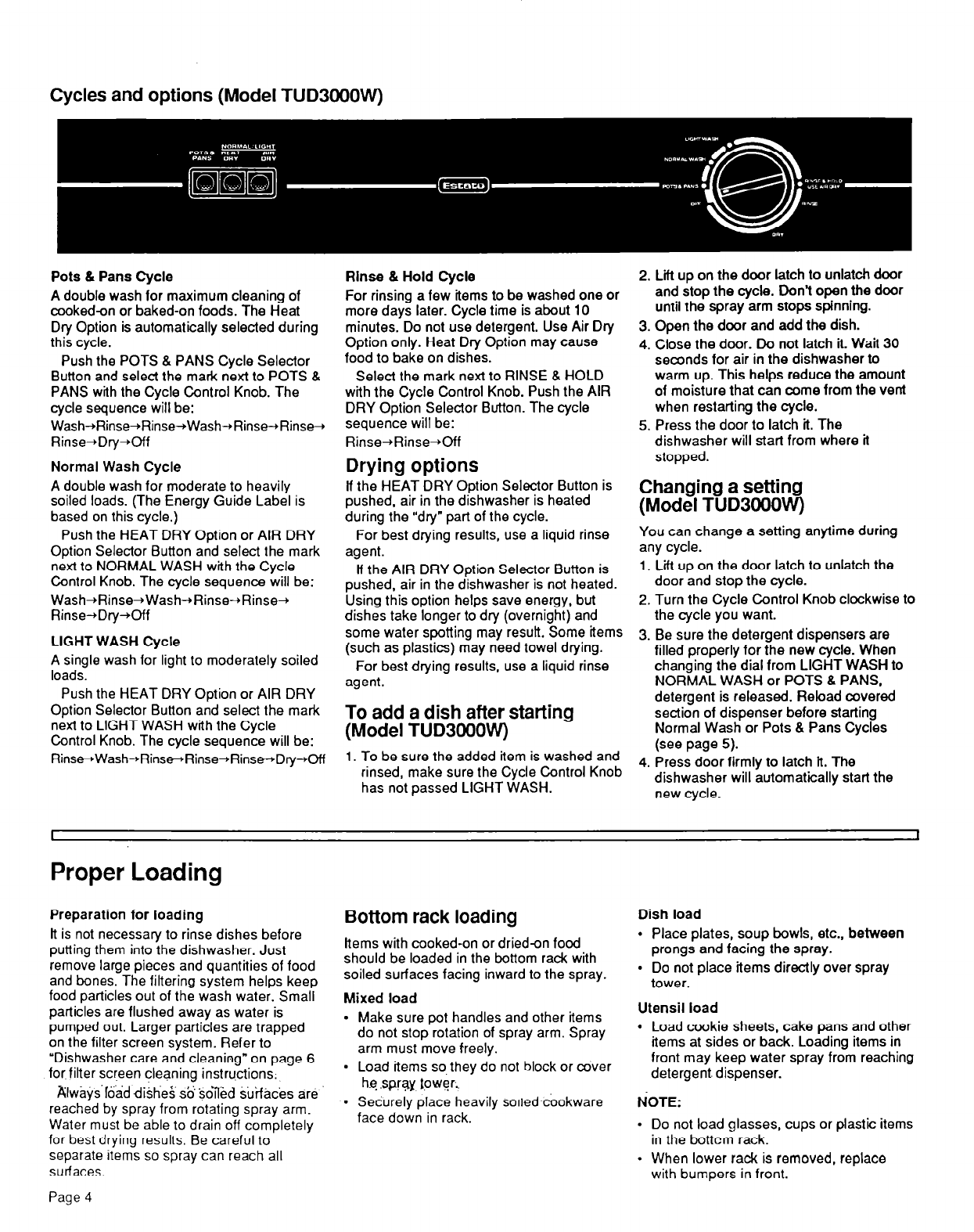
Cycles and options (Model TUD3OOOVV)
Pots b Pans Cycle
A double wash for maximum cleaning of
cookedan or baked-on foods. The Heat
Dry Option is automatically selected during
this cycle.
Push the POTS 8 PANS Cycle Selector
Button and select the mark next to POTS 8
PANS with the Cycle Control Knob. The
cycle sequence will be:
Wash+Rinse+Rinse+Wash-+Rinse+Rinse+
Rinse+Dry+Off
Normal Wash Cycle
A double wash for moderate to heavily
soiled loads. (The Energy Guide Label is
based on this cycle.)
Push the HEAT DRY Option or AIR DRY
Option Selector Button and select the mark
next to NORMAL WASH with the Cycle
Control Knob. The cycle sequence will be:
Wash+Rinse+Wash+Rinse-+Rinse+
Rinse-+Dry+Off
LIGHT WASH Cycle
A single wash for light to moderately soiled
loads.
Push the HEAT DRY Option or AIR DRY
Option Selector Button and select the mark
next to LIGHT WASH with the Cycle
Control Knob. The cycle sequence will be:
Rins@Wash-+Rinse,Rinse+Rinse+Dry-+Off
Rinse & Hold Cycle
For rinsing a few items to be washed one or
more days later. Cycle time is about 10
minutes. Do not use detergent. Use Air Dry
Option only. Heat Dry Option may cause
food to bake on dishes.
Select the mark next to RINSE & HOLD
with the Cycle Control Knob. Push the AIR
DRY Option Selector Button. The cycle
sequence will be:
Rinse+Rinse+Off
Drying options
if the HEAT DRY Option Selector Button is
pushed, air in the dishwasher is heated
during the “dry” part of the cycle.
For best drying results,
use
a liquid rinse
agent.
tf the AIR DRY Option Selector Button is
pushed, air in the dishwasher is not heated.
Using this option helps save energy, but
dishes
take
longer to dry (overnight) and
some water spotting may resutt. Some items
(such as plastics) may need towel drying.
For best drying results, use a liquid rinse
agent.
To add a dish after starting
(Model TUD3OOOW)
1. To be sure the added item is washed and
rinsed, make sure the Cycle Control Knob
has not passed LIGHT WASH.
2. Lii up on the door latch to unlatch door
and stop the cycle. Don’t open the door
until the spray arm stops spinning.
3. Open the door and add the dish.
4. Close the door. Do not latch it. Wait 30
seconds for air in the dishwasher to
warm up. This helps reduce the amount
of moisture that can come from the vent
when restarting the cycle.
5. Press the door to latch it. The
dishwasher will start from where it
stopped.
Changing a setting
(Model TUD3OOOW)
You can change a setting anytime during
any cycle.
1. Lii up on the door latch to unlatch the
door and stop the cycle.
2. Turn the Cycle Control Knob clockwise to
the cycle you want.
3. Be sure the detergent dispensers are
filled properly for the new cycle. When
changing the dial from LIGHT WASH to
NORMAL WASH or POTS 8 PANS,
detergent is released. Reload covered
section of dispenser before starting
Normal Wash or Pots 8 Pans Cycles
(see page 5).
4. Press door firmly to latch it. The
dishwasher will automatically start the
new cycle.
Proper Loading
Preparation for loading
tt is not necessary to rinse dishes before
putting them into the dishwasher. Just
remove large pieces and quantities of food
and bones. The filtering system helps keep
food particles out of the wash water. Small
particles are flushed away as water is
pumped out. Larger particles are trapped
on the filter screen system. Refer to
“Dishwasher care and cleaning” on page 6
for filter scI!en cleaning instructions.
Alwtiys’ Iliad d&e5 sb;’
‘sdiltid Siiif~c~s
are
reached by spray from rotating spray arm.
Water must be able to drain off completely
for best drying results. Be careful to
separate items so spray can reach all
surfaces.
Page 4
Bottom rack loading
Items with cooked-on or driedan food
should be loaded in the bottom rack with
soiled surfaces facing inward to the spray.
Mixed load
l
Make sure pot handles and other items
do not stop rotation of spray arm. Spray
arm must move freely.
l
Load items so. they do not block or aver
he .sprqy tpwer..
l
Securely place heavily soiled cookware
face down in rack.
Dish load
l
Place plates, soup bowls, etc., between
prongs and facing the spray.
l
Do not place items directly over spray
tower.
Utensil load
l
Load cookie sheets, cake pans and other
items at sides or back. Loading items in
front may keep water spray from reaching
detergent. dispenser.
NOTE:
l
Do not load glasses, cups or plastic items
in the bottcm rack.
. When lower rack is removed, replace
with bumpers in front.
